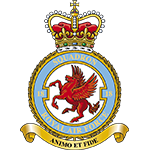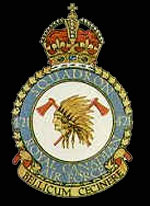

RCAF No 421 (Red Indian) Squadron
RCAF No 421 (Red Indian) Squadron
Motto: Bellicum cecinere (They have sounded the war trumpet)
Like so many other Canadian fighter squadron, it was formed at Digby, in this case on 9 April 1942. Equipped with Spitfire Vs it soon moved to Fairwood Common in South Wales, where it remained on and off until November 1942.
In January 1943 the squadron joined the Kenley Wing and was soon involved in the whole range of offensive operations conducted by the Wing, including taking part in Exercise Spartan, a major Army-Air Co-operation exercise designed to test out systms to be employed for Operation Overlord.
In May 1943 the unit's Mk V were replaced by Spitfire IXs and with these it conducted bomber escorts until August when it became part of No 127 Airfields (later No 127 Wing) and it joined in the preparations for the invasion. The squadron supported the D-Day landings and then on the 14 June, moved to the beachhead area.
It continued to move forward to remain within range of the Allied armies and the frontline but on 1 October it got to close and being only three miles from the frontline, found itself immediately under attack so it moved back to Brussels. In December the squadron re-equipped with Spitfire XVIs and was back in action. It was intended that the squadron should join the British Air Forces of Occupation but on 23 July 1945 the squadron was disbanded at Utersen.
Battle Honours
Defence of Britain 1942-43, Fortress Europe 1942-44, France and Germany 1944-45, Normandy 1944 Arnhem Rhine.
Squadron Codes used: AU Apr 1942 - Jul 1945
Book References:
- Canadian Wings: http://www.canadianwings.com/Squadrons/
- History of RAF Organisation: http://www.rafweb.org/
- Wikipedia, the free encyclopedia: http://en.wikipedia.org/
- Kostenuk, S. and J. Griffin. RCAF Squadron Histories and Aircraft: 1924-1968. Toronto: Samuel Stevens, Hakkert & Company, 1977. ISBN 0-88866-577-6.

 Editor for Asisbiz: Matthew Laird Acred
Editor for Asisbiz: Matthew Laird Acred
 Editor for Asisbiz: Matthew Laird Acred
Editor for Asisbiz: Matthew Laird Acred